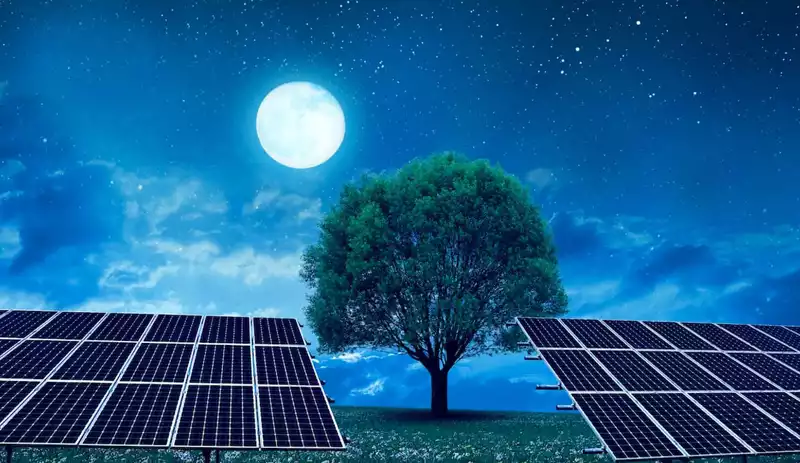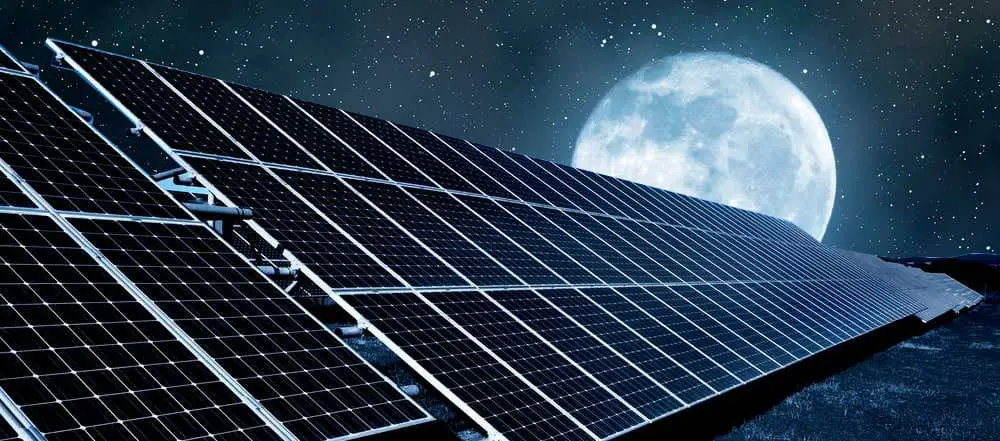You can also be interested in these:
- Greenhouse solar panels for a self-sustained crop system
- AMD Zen 3 vs Zen 4: The evolution and revolution
- What is the AMD FidelityFX Super Resolution?
- CES 2022: The year’s most anticipated tech event
Technological development in the photovoltaic sector is advancing at a swift rate. A team of scientists wondered: do solar panels work at night? How can we do this? Well, now it is possible, and the way it works is quite amazing. In fact, a photovoltaic cell specially designed for this could generate up to 50 watts of energy per square meter under ideal conditions at night, approximately 25% of what a conventional solar panel can generate during the day, according to the article “Nighttime Photovoltaic Cells: Electrical Power Generation by Optically Coupling with Deep Space” published by researchers at the Davis University of California, in the ACS Photonics journal.

Solar panels are one of the main ways to produce renewable energy from solar energy. The only problem they have, to date, is that they are unable to generate electricity when at night. In some parts of the world with drastic fluctuations in availability of daylight, such as the Nordic countries, these panels can be inefficient not only throughout the day, also during long winter and rainy seasons.
Generate energy by irradiating heat
To solve this riddle researchers point out they would use a heat-additive cell, which is capable of generating electricity thanks to radiative cooling (where infrared or heat radiation leaves the cell and produces a small amount of energy in the process). This cell should be made of a material that can capture extremely long wavelength light.
This type of thermoradiative cells are already being tested in fields such as manufacturing, where it is used to convert waste heat, such as that produced by a motor with its high temperatures. In the case of a night solar panel, pointing such a cell at the cold night sky is one way to take advantage of this process.
“A regular solar cell generates energy by absorbing sunlight, which causes a voltage to appear across the device and for current to flow”, Jeremy Munday, an electrical and computer engineer at the American university, tells Science Alert. “In these new devices, light is emitted and current and voltage go in the opposite direction, but power is still generated”.
How do solar panels work at night?
The great difficulty, however, is in the materials. A conventional solar panel is made of silicon and is good at capturing light that is largely in the visible spectrum. Other types of materials are needed to capture extremely long wavelength light, and Munday is experimenting with mercury alloys that may be optimal for this. “You have to use different materials, but the physical basis is the same,” says Munday.
This is not the only attempt to create solar panels also for the night. Last year researchers from Stanford University proposed a system that also used the heat imbalance between the night sky and the Earth to generate electricity from infrared radiation.
However, there is still a long way to go to scale this technology to become useful. Right now, Munday and his team only have prototypes in development of this relatively inexpensive way to keep solar panels running 24 hours a day. Now, do solar panels work at night? This technology is taking the first steps to answer this question.
Advancement in the technology and new developments
A team of researchers from Stanford University and the Technion-Israel Institute of Technology have theoretically optimized the existing infrastructure for solar panels: the thermoelectric power generators. These generators create electrical voltage by converting the temperature differences between a heat source (for example, ambient air temperature at night) and a specially cooled surface of the generator.

Although these generators already exist, the study authors argue that they are not living up to their potential and that they are not sustainable options for off-grid power generation.
Lingling Fan, the first author of the study and a Ph.D. candidate in electrical engineering at Stanford University, says his study aims to optimize this existing design:
We are working to develop high-performance sustainable lighting generation system that can provide everyone (including those in rural and developing areas) access to reliable and low-cost lighting energy sources.
Fan says a modular energy system like this could even be used to convert waste heat from cars into usable energy.
Despite its linguistic similarity to the common solar panel, anti-solar panels do not look like conventional photovoltaic panels.
The team has experimented testing different improvements, such as the way heat flows through the system and the use of commercially available thermoelectric materials to improve the efficiency of the system in the use of its energy.
Wei Li, a co-author of the study and a postdoctoral fellow at Stanford, says that one of the most important changes they simulated was the use of a material to better control how the generator dumped excess heat.
One of the most important innovations was the design of a selective emitter that is fixed on the cold side of the device. This optimizes the radiation cooling process so that the power generator can more efficiently get rid of excess heat.
After analyzing these simulated improvements, the team found that their design was capable of generating 2.2 watts of power per square meter (2 W / m2), which is 120 times more power than previous experimental models have been capable of. to achieve, the authors write.
The authors also that a system like this could even be used during the day, creating an overlay of energy production with traditional solar panels.
That being said, there is a difference between the simulated results and how this system might actually work.
However, the authors argue that this design demonstrates that the system is theoretically achievable using commercially available technology, we don’t have to wait for new materials or innovations. In the future, this off-grid solution could be used to supply sustainable energy and power essential services.
More stories like this
- Greenhouse solar panels for a self-sustained crop system
- AMD Zen 3 vs Zen 4: The evolution and revolution
- What is the AMD FidelityFX Super Resolution?
- CES 2022: The year’s most anticipated tech event
- Graphene Aerogel: the lightest material on earth
- IBM optical circuits: Next-gen computers powered by light